Chapter 4
The Suit of Painting
THE EMBODIMENT OF INNER VISION.
GIVING FORM TO SPIRITUAL LIGHT.
THE PATH OF SENSATION & SPIRIT.
Painting admits
not a grain of sand or a blade of grass insignificant...
—Characteristics
of the Suit
—The Number Cards
1-Generation
2-Balance
3-Practice
4-Means
5-Hardship
6-Assistance
7-Patience
8-Discipline
9-Fruition
10-Delight
—The
Person Cards
Angel
of Painting
Child of Painting
Woman of Painting
Man of Painting
Characteristics
of the Suit
The Creative Process Suit of Painting
represents the physical manifestation of divine imagination. It corresponds
to the Suit of Pentacles in conventional Tarot. Its symbol is the artist's palette
and brushes. Tharmas, the Zoa of Matter, presides over this suit. Painting is
associated with manifestation or work, with the senses of taste and touch, and
with manual precision such as used in drawing and surgery. The cards in this
suit portray situations and states of being that pertain to the human body,
its functions, and instincts, or to things in the vegetated world, to natural
objects, to money and materiality — in short, to anything that is created
and has physical form. Its element is Water, which is fluid and plastic, like
the physical arts and the physical body. Also, the body and the world of matter
are composed mostly of water. When pertaining to works of art, Painting specifically
includes all the two-dimensional graphic arts such as painting, drawing, etching,
and so forth. It also includes the three-dimensional arts such as sculpture
and ceramic arts, and many crafts based on form. Anything based on the body,
such as sports and martial arts, and the forms of nature is included in this
suit. For Blake, the medical and surgical arts are also part of Painting, although
as "degraded" or fallen forms because they deny imagination.
Basically, the Suit of Painting
expresses one's inner vision, not the replication of nature. The true painter-artisan-manifester
gives form to what he or she 'sees' in the eternal world of the imagination,
not to what is mechanically perceived in the created world. "No man of
sense can think that an imitation of the objects of nature is the art of painting."
Imagination is the immortal power
of forming images in the mind, and Painting is the mortal power of manifesting
those images within time and space. But all created things are bounded by dimensions
and time; they are finite and temporary, and eventually die or disintegrate.
By contrast, images conceived by the imagination are boundless and timeless,
for they partake of eternity and are man's portion of the divine.
The painter of
this work assets that all his imaginations appear to him infinitely more perfect
and more minutely organized than any thing seen by his mortal eye.
The upper borders of all the suit
cards depict the clouds that Blake associates with the body — which, formed
of water (matter) gives the illusion of substance but is vaporous and readily
evaporates, and it blocks vision of the infinite. The lower borders of all the
cards depict the flow of water (matter) in various forms, sometimes anthropomorphically
in the forms of faces and human limbs that appear in the flow. The inner edges
of the card borders are blue to symbolize the element of water. The faint designs
of floating figures in the Symbol Windows are eternal Form seen with the inner
vision that characterizes this suit; these myriad forms express Blake’s belief
that all things are human. Taken as a whole, the cards of this suit are instructive
in that they present a workable plan for achieving material success.
The Number
Cards
The ten Number Cards in the Suit
of Painting are drawn from diverse works of Blake's, and suggest the range of
his literary and symbolic subject matter.
Ace of
Painting — Generation
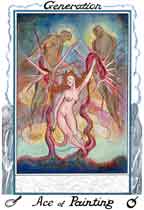 This
card depicts a naked woman grasping two starry phalluses that snake upwards
from the sea of time & space and yet belong to the unformed angels that hover
over her. This image of the generative forces of materiality was one of Blake's
last works, and shows his own gift for creativity undimmed by age. The woman
is the prophet Enoch's vision of "the daughter of men," and the angels
are her own inner vision, which will impregnate her and generate all the forms
and artifacts of humanity.
This
card depicts a naked woman grasping two starry phalluses that snake upwards
from the sea of time & space and yet belong to the unformed angels that hover
over her. This image of the generative forces of materiality was one of Blake's
last works, and shows his own gift for creativity undimmed by age. The woman
is the prophet Enoch's vision of "the daughter of men," and the angels
are her own inner vision, which will impregnate her and generate all the forms
and artifacts of humanity.
In Blakean iconography, she could
be Enion, the Emanation of Tharmas, the Zoa of Matter. Enion represents the
generative instinct, or lust. In Blake's myth, she and Tharmas are the parents
of Los and Enitharmon (thus matter gives birth to time and space). Her gift
is sensation, the sensuality that allows form to recognize itself.
In Generation, we see woman at the
center of things: controlling, moving, animating the "vegetative"
or materialized world. She draws raw energy from the cosmos and seduces the
gods in order to create "all things both small and great" with her
sensational and irresistible powers. Her brazen fertility suggests the unlimited
nature of the generative force that transforms spirit into matter.
This card shows that you have the
gift of energy and the urge to create — but you must direct this flow.
This is a burst of creativity that rises up spewing and spurting ideas, which
may, however, fall barren if you do not grasp and direct its output, like this
creatrix who manipulates energy into tangible form. Generation shows you handling
and using the cosmic resources available to you.
In the creative process,
this is the gift of generation, the basic urge to create. It is when you sense
energy rising in you that must be grabbed and directed into a project. You should
accept the challenge.
KEYWORDS: GIFT OF GENERATIVE
POWER • ORIGINATION OF IDEAS AND PROJECTS • FOCUSING YOUR INNER VISION
• MANIFESTING YOUR ENERGY • SENSUALITY • VITALITY • FERTILITY
• CREATIVE POWER •
2 of Painting
— Balance
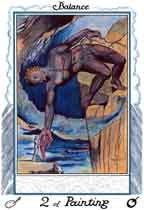 This
card illustrates a passage from Dante's Divine Comedy, and shows the mythological
giant Antaeus helping the poets Virgil and Dante to bridge a chasm. As metaphor,
it operates on several levels to illustrate duality and kinesthetic intuition.
This
card illustrates a passage from Dante's Divine Comedy, and shows the mythological
giant Antaeus helping the poets Virgil and Dante to bridge a chasm. As metaphor,
it operates on several levels to illustrate duality and kinesthetic intuition.
Perhaps these are the same angels
generated in the Ace, here continuing their journey as manifested spirits. They
must make choices, represented by the chasm, and their motive power is physical
intuition, represented by the giant. In order to overcome obstacles you need
to harness your inner powers; you must stretch yourself, set things in motion,
and yet keep a firm grasp on your place. This requires a delicate balance and
yet agility based on inner strength.
On the other hand, the two poetic
figures can represent the imagination, while the giant personifies materialism.
The chasm depict their separation in this rocky world. Yet imagination must
come to terms with manifestation to cross the chasm of duality. Physical health,
material resources, and economic support are vital to translate imagination
into practical form. The giant's arm is intuition reaching across the division
that separates art and nature. Above the giant's head, the cloud is split into
fire and water, into heat and cold; this is the the dualistic nature of materialism
that must be breached by the helping hand of intuition.
This card suggests that you can
use your bodily intuition, not fearing to hang over the abyss of the unknown,
to set your ideas on the path of development. Balance yourself between idea
and form, between potential and loss of control, between impulse and action.
The energy must now move outward. You need to put your resources to work.
In the creative process,
this is the choice at the beginning of a project, the decision to stretch yourself
to go on. You must use your present strengths to bridge the gap of possibility,
setting new ideas on the path of growth and development.
KEYWORDS:
MEANING:
USE OF PRACTICAL WISDOM • PHYSICAL MOBILITY • CHOOSING BETWEEN PHYSICAL
OPTIONS • NEGOTIATION. INTERACTION • CHOICES • CHANGE •
DUALITY •
3 of Painting
— Practice
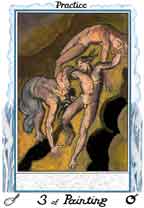 Here
we see "three falling figures" grappling and tumbling through layers
of clouds representing Neoplatonic levels of bodily manifestation. The middle
figure is the focus of the composition, and the others are aspects of himself
that he learns how to manipulate. One is bearded and clothed, representing sophistication
and worldliness, while the other is nude and youthful (perhaps female) —
thus part of the practice involves finding the middle way of synthesis and practicality.
This card is about working or molding something, and learning about control
and finesse. It takes skill and practice to find a way that works. As in movement
exercises like 'contact improvisation', the real skill comes in the flow of
working together with others (or other parts of oneself), integrating each individual's
movement so that it becomes a part of the whole. With practice, the descent
into form becomes a kind of dance, the discovery of a shape that works. Practice
allows you the skill to bring others with you. You must practice to get any
process right, and then you can show others how it is done.
Here
we see "three falling figures" grappling and tumbling through layers
of clouds representing Neoplatonic levels of bodily manifestation. The middle
figure is the focus of the composition, and the others are aspects of himself
that he learns how to manipulate. One is bearded and clothed, representing sophistication
and worldliness, while the other is nude and youthful (perhaps female) —
thus part of the practice involves finding the middle way of synthesis and practicality.
This card is about working or molding something, and learning about control
and finesse. It takes skill and practice to find a way that works. As in movement
exercises like 'contact improvisation', the real skill comes in the flow of
working together with others (or other parts of oneself), integrating each individual's
movement so that it becomes a part of the whole. With practice, the descent
into form becomes a kind of dance, the discovery of a shape that works. Practice
allows you the skill to bring others with you. You must practice to get any
process right, and then you can show others how it is done.
In the creative process,
this is when you experiment — practicing and learning how to manipulate
and work the situation, developing the skills you need, especially in relation
to other people.
KEYWORDS: ACHIEVEMENT THROUGH
PRACTICE AND WORK • PRACTICALITY • SYNTHESIS AND GROWTH • MATERIALWORKS
• INTEGRATION • EXERCISE OF SKILLS •
4 of Painting
— Means
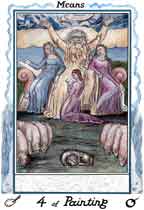 This
collaged imaged shows the biblical figure of Job, surrounded by his daughters
and his prosperity. He is a man of means, relating his life story — symbolized
by the visions above him. His daughters, holding symbols of the arts, are his
familial and cultural wealth; the sheep at left and right symbolize his material
wealth. Although the cloud behind him separates his visions from his earthly
state, his hands reach into the ethereal realm and connect him with spiritual
energies as well.
This
collaged imaged shows the biblical figure of Job, surrounded by his daughters
and his prosperity. He is a man of means, relating his life story — symbolized
by the visions above him. His daughters, holding symbols of the arts, are his
familial and cultural wealth; the sheep at left and right symbolize his material
wealth. Although the cloud behind him separates his visions from his earthly
state, his hands reach into the ethereal realm and connect him with spiritual
energies as well.
This card is about having the means
to feel secure in your environment, and the physical resources to manifest your
inner vision. You may reach into the spiritual realm for ideas, but you still
need the implements, tools, raw materials, time, and space to give those ideas
form. Practice, skill, and ability, as developed in the previous card, are only
part of the story. This card also shows a sense of contentment. This can sometimes
be counterproductive, for we can become lazy or complacent, like the dog in
front, or even stagnant. We can also become fearful of loss and therefore compulsive
about holding on too tightly to what we have.
In the creative process,
this is when you determine the means and resources you need to accomplish your
task.
KEYWORDS: FINANCIAL OR MATERIAL
SECURITY • INCREASE IN POWER • AMPLE MATERIALS AND CONTROL •
CREATING STRUCTURE AND ORDER • PHYSICAL CONSOLIDATION • CONTENTMENT
• COMPLACENCY • MISERLINESS • STAGNATION •
5 of Painting
— Hardship
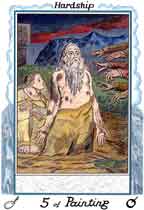 As
in the previous card, this is Job — but now fallen on hard times and accused
by his friends, but still accompanied by his wife. Although kneeling in supplication,
he is on barren ground, and alienated from the true god (note the Druidic post).
All of the hands in this image are expressive: scorn and disgust are seen in
those of the accusers, who seem well-dressed, worldly, and prosperous.They may
belong to Tharmas (the sensual man), Urizen (the reasoning man), and Luvah (the
man of feeling). The hands of Job's wife are self-protective rather than supportive.
Although Job's open palms proclaim his honest innocence and his eyes look heavenward
for guidance, he is basically alone in his hardship. His partial nudity dramatizes
the nakedness of his appeal and the indignity of his suffering. He will endure,
however; his beard symbolizes the wisdom and strength that will see him through,
and a small symbolic patch of grass at his feet is a harbinger that all is not
lost. In this card, we are shown material reverses, physical illness, or punishment
for behavior outside the norm. We are misunderstood or castigated, ejected from
the comfort and complacency of the previous card.
As
in the previous card, this is Job — but now fallen on hard times and accused
by his friends, but still accompanied by his wife. Although kneeling in supplication,
he is on barren ground, and alienated from the true god (note the Druidic post).
All of the hands in this image are expressive: scorn and disgust are seen in
those of the accusers, who seem well-dressed, worldly, and prosperous.They may
belong to Tharmas (the sensual man), Urizen (the reasoning man), and Luvah (the
man of feeling). The hands of Job's wife are self-protective rather than supportive.
Although Job's open palms proclaim his honest innocence and his eyes look heavenward
for guidance, he is basically alone in his hardship. His partial nudity dramatizes
the nakedness of his appeal and the indignity of his suffering. He will endure,
however; his beard symbolizes the wisdom and strength that will see him through,
and a small symbolic patch of grass at his feet is a harbinger that all is not
lost. In this card, we are shown material reverses, physical illness, or punishment
for behavior outside the norm. We are misunderstood or castigated, ejected from
the comfort and complacency of the previous card.
This card symbolizes a state in
which you may feel alienated, attacked, afflicted, or ganged up on — most
likely through no fault of your own. There is a sense of suffering for your
convictions and beliefs because they thrust you outside what is acceptable in
society. Perhaps you are taking an unpopular stand for your beliefs. However,
there is a measure of support in your situation, perhaps someone who believes
in what you are doing, who is willing to stand beside you. And your inner resolve
and faith are still viable though threatened. Your best defense is your own
honesty and candor.
In the creative process,
this is the realization that the problems you are trying to solve may put you
at odds with others who do not recognize your value. This also signifies personal
blocks and fears of rejection, inner voices telling you the 'reasons' that something
won't work.
KEYWORDS: MATERIAL PROBLEMS.
ANXIETY • FINANCIAL (OR SPIRITUAL) LOSS • ILLNESS • SIMPLIFYING
DUE TO DIFFICULTY • STRIPPING DOWN TO BASICS • UNCONVENTIONALITY •
VOLUNTARY SIMPLICITY • SOCIETY VERSUS THE INDIVIDUAL •
6 of Painting
— Assistance
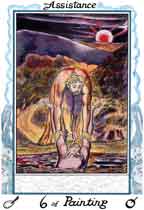 This
card depicts an early scene from John Bunyan's spiritual epic, Pilgrim's Progress,
in which Christian is pulled from the 'Slough of Despond' by a character called
Help. Christian has already been abandoned by his initial companion, and he
unable to extricate himself from the slough due to the weight of his sins on
his back. Beyond, we see the path leading to enlightenment, symbolized by the
sun.
This
card depicts an early scene from John Bunyan's spiritual epic, Pilgrim's Progress,
in which Christian is pulled from the 'Slough of Despond' by a character called
Help. Christian has already been abandoned by his initial companion, and he
unable to extricate himself from the slough due to the weight of his sins on
his back. Beyond, we see the path leading to enlightenment, symbolized by the
sun.
This card is about receiving material
benefits from others, without whose assistance we cannot continue on the high
road to achievement, health, or happiness. Regardless of sin, Assistance is
always welcome. It is the gift of successful relationships, achieved through
generosity of spirit and sharing of resources. Note that the nature of the help
being offered and/or received is ambiguous due to the positioning of the hands.
We assume that the man on the bank is pulling the other out of the water in
order to save him, to place him back onto the road that leads into the high
ground of the spirit. However, he could also be lowering the other into the
water, perhaps a baptism in the waters of life or an immersion for the purpose
of healing. The man in the water might also be assisting the one on the bank
to join him in the flow, to share the waters of life with him. With this card,
you attract or give something of value — whether help, charity, awards,
or patronage. You exchange material energy towards a worthwhile goal. The challenge
is to give unconditionally, according to your ability, and to receive what is
freely given.
In the creative process,
this is when you receive support or patronage, either from another or from seeing
a new option or path open up. You attract what is needed to keep you going on
your project.
KEYWORDS: GIFTS GIVEN/RECEIVED
• PRACTICAL HELP. ENERGY EXCHANGES • PHYSICAL RECIPROCITY, MAGNANIMOUS
SHARING • PATRONAGE • EMERGENCE/IMMERSION • CARE OF THE BODY.
HEALING •
7 of Painting
— Patience
 This
card is a collage of two images from Blake's Jerusalem. In the lower part, Jerusalem,
who represents Liberty, sits in a Druidic landscape awaiting (or perhaps summoning)
the forces of the four Zoas to emerge from the earth around her, as a new day
dawns. In the upper part, a maiden in harness patiently pulls the new moon along
a track of clouds into the stars.
This
card is a collage of two images from Blake's Jerusalem. In the lower part, Jerusalem,
who represents Liberty, sits in a Druidic landscape awaiting (or perhaps summoning)
the forces of the four Zoas to emerge from the earth around her, as a new day
dawns. In the upper part, a maiden in harness patiently pulls the new moon along
a track of clouds into the stars.
This card signifies the need to
wait until a current period of uncertainty has passed. The upper figure symbolizes
time as a triple-starred female presence, harnessed to eventually bring forth
the new and loving energy of the moon. The moon also symbolizes female menstruation,
a time of cleansing and purification. Both figures are women, emphasizing that
this is a period of creative gestation. In the lower portion, Jerusalem's neck
is bent by the weight/wait of time just above her, but her hands signify an
attitude of patience and endurance. There is also the sense of opening oneself
up to whatever comes. Jerusalem's gestures go beyond mere acceptance, however.
Like the figure in harness who is working to change the situation, Jerusalem's
hands show that she is an active force; they are like wands releasing the elemental
powers in the situation, which will bring new freedom of action following this
stage of testing and delay. This is a time during which it is difficult to get
things done, but the Zoas, the "four faces of man" are now being liberated,
and the dawning of the next stage is evident.
In the creative process,
this is the fallow period when you must relax and wait; straining will get you
nowhere. Seeds planted will emerge on their own; subconscious visions and daydreams
may bring innovative solutions.
KEYWORDS: AWAITING EMERGENCE
• UNCERTAINTY DESPITE MUCH WORK • FEAR OF FAILURE • APPREHENSION,
TESTS AND TRIALS OF MANIFESTATION • DELAYS. SLOW GROWTH •
8
of Painting — Discipline
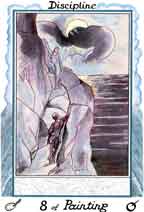 This
is a scene from Dante's Divine Comedy in which the poets Virgil and Dante ascend
the mountain of Purgatory. This could be an illustration of Blake's own statement
that "temptations are on the right hand & left; behind, the sea of time
& space roars & follows swiftly; he who keeps not right onward is lost."
The light of the sun is obscured, and there is an air of overall danger. However,
Virgil — as the guide and mentor of Dante — is in the lead, and takes
the next higher step with both his right hand and right foot; he is the higher
wisdom guiding the soul through purgatory — the state of expiation and
sacrifice preceding breakthrough.
This
is a scene from Dante's Divine Comedy in which the poets Virgil and Dante ascend
the mountain of Purgatory. This could be an illustration of Blake's own statement
that "temptations are on the right hand & left; behind, the sea of time
& space roars & follows swiftly; he who keeps not right onward is lost."
The light of the sun is obscured, and there is an air of overall danger. However,
Virgil — as the guide and mentor of Dante — is in the lead, and takes
the next higher step with both his right hand and right foot; he is the higher
wisdom guiding the soul through purgatory — the state of expiation and
sacrifice preceding breakthrough.
The process of growth and transformation
begun in the previous card is still in motion. In addition to patience, prudence
is now indicated. The goal is not yet at hand, and you will need self-discipline
and preparation to reach the summit. You can climb slowly but surely toward
your goal, making every step count, but it is advisable to learn new skills
at the same time that you exercise the old ones. It is useful to define one’s
values, to learn the terrain. Plan your moves, and be cunning, skillful, and
steadfast.
In the creative process,
this is when you discipline yourself for the long haul. This suggests a step-by-step
implementation of the project that leads ever closer to the goal.
KEYWORDS: PERSEVERANCE IN THE
FACE OF DIFFICULTY • PRUDENCE. EDUCATION AND TRAINING • PHYSICAL ASSESSMENT
• PRACTICALITY • SELF-IMPROVEMENT • DEFINING ONE'S VALUES •
9 of Painting
— Fruition
 This
is the first state of an etching from Blake's Jerusalem, showing Albion and
Vala embracing in sexual intercourse upon a water lily (water lotus), while
the phallic caterpillar of natural sex crawls out from beneath their entwined
torsos. In the revised final state, the couple merely embrace, without any caterpillar.
Symbolically, the original image portrays humankind seduced by nature, and expresses
our fascination with bodily pleasure and the material world. Note that the lovers
are wrapped in the Blake's "golden net of marriage." In Blake's storyline,
Albion subsequently becomes prudish about this and repudiates "every labor
of love in all the garden of Eden." Nevertheless, the moment depicted here
is one of erotic fruition, although not of completion, and in some measure represents
Blake's ideal of sexuality and sensuality.
This
is the first state of an etching from Blake's Jerusalem, showing Albion and
Vala embracing in sexual intercourse upon a water lily (water lotus), while
the phallic caterpillar of natural sex crawls out from beneath their entwined
torsos. In the revised final state, the couple merely embrace, without any caterpillar.
Symbolically, the original image portrays humankind seduced by nature, and expresses
our fascination with bodily pleasure and the material world. Note that the lovers
are wrapped in the Blake's "golden net of marriage." In Blake's storyline,
Albion subsequently becomes prudish about this and repudiates "every labor
of love in all the garden of Eden." Nevertheless, the moment depicted here
is one of erotic fruition, although not of completion, and in some measure represents
Blake's ideal of sexuality and sensuality.
In the card, collaged with other
graphic elements from Jerusalem, we see the drama of this moment of ecstasy:
the fish below represent the chain of life feeding on itself, the clouds of
pink are sensual rapture, and the nine angelic gyres represent the ennead, the
overseeing angels of human development. The water lily floating on the sea of
time & space represents fertility, its roots in the mud but its flower a bed
of purity and beauty. An alternative interpretation is that these lovers are
Tharmas and Enion, the body and its desire, joined in rapture.
This card represents the sensual
harvest of the suit, the full flowering of one's creations, the enjoyment of
the senses, or being all wrapped up in something. Symbolically its sexuality
is a metaphor for material gain, physical well-being, pleasure, satisfaction,
and money. These are the rewards of being in harmony with nature and the forces
around you. When you act in a definite and practical manner, you ultimately
achieve the successes that accrue from this practice.
In the creative process,
this is the combining of two disparate things into something new and fruitful,
a definition of the creativity. This signifies the proper appreciation and use
of what is being created.
KEYWORDS: MATERIAL GAIN •
PLEASURE AND LEISURE • PHYSICAL REWARDS GAINED THROUGH EFFORT • PRACTICAL
ACTIONS RESULTING IN PHYSICAL SUCCESS • ATTAINMENT • GLOWING HEALTH
• MATERIAL SERENITY AND WELL-BEING • COMPLETING THE WORK OF MANIFESTATION
• WRAPPED IN SENSUALITY • BEING A FRUITFUL PART OF THE CHAIN OF EXISTENCE
•
10 of
Painting — Delight
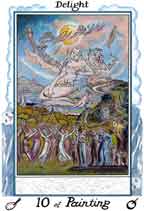 This
card represents the culmination of the physical cycle, expressed in the combination
of merry humans and the rising spirits of the natural world, together with the
harmony of earth and sky, village and country, young and old sporting together.
There are a great many things going on this card, with its profusion of symbols,
shapes, and colors, but its overall sensation of delight in life and nature
is unmistakable. Some augmenting details are worth noting:the angelic trumpeters
in the sky are joined by two others at the mid right side, while other angels
bear urns and baskets of plenty into the heavens. The Olympian figures are humanized
mountains: the goddess cradles a city in her lap and a waterfall under her arm;
her mural crown signifies her role as protectoress, while the male god has a
laurel crown and a road emanates from his armpit.
This
card represents the culmination of the physical cycle, expressed in the combination
of merry humans and the rising spirits of the natural world, together with the
harmony of earth and sky, village and country, young and old sporting together.
There are a great many things going on this card, with its profusion of symbols,
shapes, and colors, but its overall sensation of delight in life and nature
is unmistakable. Some augmenting details are worth noting:the angelic trumpeters
in the sky are joined by two others at the mid right side, while other angels
bear urns and baskets of plenty into the heavens. The Olympian figures are humanized
mountains: the goddess cradles a city in her lap and a waterfall under her arm;
her mural crown signifies her role as protectoress, while the male god has a
laurel crown and a road emanates from his armpit.
This card depicts a scene from Milton's
L'Allegro called "A Sunshine Holiday." Blake said of it:
In this design
is introduced mountains on whose barren breast
the labring clouds do often rest. Mountains, clouds, rivers, trees appear
humanized on the Sunshine Holiday.
The church steeple with its merry bells.
The clouds arise from the bosoms of mountains,
while two angels sound their trumpets in the heavens to announce the Sunshine
Holiday.
Despite their overall prosperity,
all these figures are still within the world of Generation, trapped within the
flesh. They are the same people who appear in XIII—Transformation. Blake
hints at this by placing the butterfly of Psyche, symbolizing the soul, off
to the lower right, while just above is a tree spirit with the face of Jesus,
looking upon the frolic with an air of sadness. Blake's message is always that
salvation lies in the spirit, in the imagination, not the body.
In the creative process,
this is when you celebrate, not only your own achievements, but those of others.
This is the creation of culture as the conglomerate and cooperative work of
many. But you should not overlook spiritual concerns underlying your work.
KEYWORDS: MATERIAL PROSPERITY
• GOOD FORTUNE • ESTABLISHED TRADITIONS • HARMONY AMONG ALL THE
ELEMENTS OF THE SITUATION • FINANCIAL OR FAMILY SECURITY • CULMINATION
•
The Person
Cards
Like the Number Cards, the central
images used in the four Person Cards of the Suit of Painting are selected from
a variety of Blake's works.
Angel
of Painting
(Air of Water — Mind in Matter)
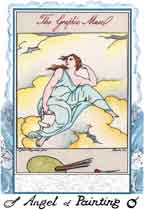 Labeled
"The Graphic Muse," we see a robed angel-woman who securely sits on
a cloud and gazes over her right (spiritual) shoulder as she holds a scroll
of inspiration in her right hand. This image is Blake's frontispiece to a book
about art. Below it are several tools of the graphic artist: palette, brushes,
and engraving tool. The clouds on which the angel rests are metaphorically the
material bodies of men, which from a spiritual perspective are but vapors soon
to evaporate. Therefore, the visual arts should not dwell on the mortal but
on the "the eternal body of man [which] is the IMAGINATION." Works
of art should not be imitations of nature, but expressions of the artist's own
identity; that is, the forms of inner vision, here symbolized by the muse's
upward gaze.
Labeled
"The Graphic Muse," we see a robed angel-woman who securely sits on
a cloud and gazes over her right (spiritual) shoulder as she holds a scroll
of inspiration in her right hand. This image is Blake's frontispiece to a book
about art. Below it are several tools of the graphic artist: palette, brushes,
and engraving tool. The clouds on which the angel rests are metaphorically the
material bodies of men, which from a spiritual perspective are but vapors soon
to evaporate. Therefore, the visual arts should not dwell on the mortal but
on the "the eternal body of man [which] is the IMAGINATION." Works
of art should not be imitations of nature, but expressions of the artist's own
identity; that is, the forms of inner vision, here symbolized by the muse's
upward gaze.
This is the part of yourself that
seemingly drifts, dreams, and waits for something to coalesce inside of you.
In a creative reverie you find yourself staring out a window, or into a corner
of the room, or at your work without seeing anything that is actually there.
In the moment before you plunge back to work, the detail or next phase then
arises as if from nowhere, flowing directly through your hand into its embodiment.
Manifesting depends on integrating vision and technique. Art, like the Suit
of Painting, is about manifesting and materializing; it needs appropriate technology
as well as vision.The only danger here is being 'up in the clouds', unable or
unwilling to bring vision into actuality.
The archangel Raphael, being the
guardian of the physical world and specifically concerned with healing, is associated
with this card. Raphael ('healing from God') was also the counselor of Adam
and Eve in Paradise Lost (see VI—Knowledge). Although Raphael is not directly
related to the Angel of Painting, both angels can be regarded as divinities
that teach and heal.
In the creative process,
this may be a soaring insight, the catalysis of an idea, or the impact of a
role model. When you admire someone else's vision, and not just the products
of it, you are seeing their 'angel'.
KEYWORDS: ARTISTIC VISION •
DIVINE IMAGINATION • APPROPRIATE TECHNOLOGY • DOING ONE'S WORK OR
PROCESS • GIFTS FROM THE ARCHETYPAL REALM • STABILITY OF VISION •
THE HEALING POWER OF ART •
Child
of Painting
(Earth of Water
— Spirit in Matter/Mater)
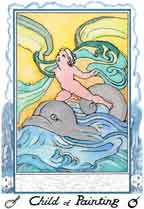 This
card is from an etching for an edition of Hesiod's Theogony, and depicts one
of the 'putti' or Cupid-like children riding on a dolphin that accompanies Aphrodite
as she is born from the sea's foam. Cupid, Aphrodite's son, represents innocent
sexuality. His flowing banners herald the coming of the goddess, and symbolize
psychic energy. Dolphin in Greek means 'womb' and represents the fertility of
the goddess. In Greek art, dolphins are souls swimming to the next world for
rebirth. As one ephemeral world vaporizes a new one is formed, and the soul
arises like swimming through matter. The famous image of the "Boy on a
Dolphin" is that of the young sun-god Apollo, reborn each morning from
the womb of the sea.
This
card is from an etching for an edition of Hesiod's Theogony, and depicts one
of the 'putti' or Cupid-like children riding on a dolphin that accompanies Aphrodite
as she is born from the sea's foam. Cupid, Aphrodite's son, represents innocent
sexuality. His flowing banners herald the coming of the goddess, and symbolize
psychic energy. Dolphin in Greek means 'womb' and represents the fertility of
the goddess. In Greek art, dolphins are souls swimming to the next world for
rebirth. As one ephemeral world vaporizes a new one is formed, and the soul
arises like swimming through matter. The famous image of the "Boy on a
Dolphin" is that of the young sun-god Apollo, reborn each morning from
the womb of the sea.
Cupid, leaping excitedly on the
back of the dolphin, is the part of yourself or another that seeks new sensations,
and is gaining strength and balance. Impervious to fear, you take risks as you
explore the world around you. You do not ask for anything to have meaning, you
want only to flood your senses with material that you will one day mold into
new forms. You are learning just how far your body or any material form can
take you. This child has thrown itself onto the womb-source or matrix from which
things originate or develop, and is riding its generative force.
In the creative process,
this is when you plunge into experimentation with form, working the materials
(matrix) just to see what will emerge or be disgorged, taking innocent joy in
the assault on your senses once that matrix has been breached.
KEYWORDS: BIRTH OF POTENTIAL
FORMS, OR NEW PROJECTS • JOYFUL RELEASE AND FLOW OF ENERGY • EMERGING
SEXUALITY • SEEING EACH DAY AFRESH • RIDING THE WAVE OF OPPORTUNITY
• DEVELOPING PRACTICAL SKILLS • A LITERAL CHILD OR YOUR INNER CHILD,
EXPLORING EXPERIENCE •
Woman
of Painting
(Water of Water — Matter in Matter)
 This
card is from a watercolor, retouched and collaged, that depicts Athene, the
virgin goddess of wisdom, war, and the arts. Garbed in red, she presides over
menstruation and blood, and invented all the kinds of work in which women were
employed. In the arts, she represents elegance combined with usefulness. In
war, she represents intelligence and prudence in lieu of force. Athene's head
and crested war helmet are here framed in a cloud (symbolizing body and matter
in Blake's scheme), suggesting that her mind is occupied with practical and
physical concerns. She awards her sacred olive wreaths to several artists for
their industry, competence, and trustworthiness.
This
card is from a watercolor, retouched and collaged, that depicts Athene, the
virgin goddess of wisdom, war, and the arts. Garbed in red, she presides over
menstruation and blood, and invented all the kinds of work in which women were
employed. In the arts, she represents elegance combined with usefulness. In
war, she represents intelligence and prudence in lieu of force. Athene's head
and crested war helmet are here framed in a cloud (symbolizing body and matter
in Blake's scheme), suggesting that her mind is occupied with practical and
physical concerns. She awards her sacred olive wreaths to several artists for
their industry, competence, and trustworthiness.
This is the part of yourself or
another who is secure in their self-worth. You value your talents, enjoy work,
and appreciate a job well-done. You express yourself most easily through your
endeavors, whether it's a fresh loaf of bread, a newly built house, or a work
of art. You look to nature for your inspiration, and to feed you on all levels.
You value others' worth based on their actions, not their words. The Woman of
Painting is reliable, conscientious, practical and responsible. She is patient
and enduring, demonstrating great emotional strength and tenacity. As indicated
by the pained expression on the sculpted head, her greatest fear is being disembodied
or unattached to something material. She gives form to the intangible, to lock
onto the passing phenomena, to immortalize a moment. The close congregation
of these persons in an outdoor agora suggests their social skills and cooperative
harmony.
In the extreme, you or another can
become stubborn, and controlling of others. You may feel the need to amass money
and possessions as proof of your worth and security, to hold on too tightly
to those who are closest, or to live life through them.
In the creative process,
this card shows the act of physically bringing your imaginings into tangible
form: you are producing the work. You take pleasure in the slow unfoldment of
what others may see as tedious tasks, for to you they are embodied vision
KEYWORDS: COOPERATIVENESS AND
SOCIAL SKILLS • APPRECIATION OF PRACTICAL ELEGANCE • INDUSTRY AND
COMPETENCE • RELIABILITY AND PATIENCE • DESERVED REWARDS • CONTROLLING,
STUBBORN • NEED FOR POSSESSIONS • TANGIBLE VALUES • RITUAL PURIFICATION
•
Man
of Painting
(Fire of Water — Passion in Matter)
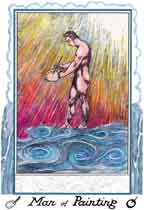 This
image is a collage that portrays the spiritual art of painting as a combination
of illumination and manifestation, respectively symbolized by the light of inspiration
streaming around the figure with increasing density as it descends, and by the
water of materialism upon which he magically walks. Although he exposes himself
to the energy of the elements, he does not get sucked under by them. The image
depicts an exalted rainfall of sensory stimulation, producing underlying vortexes
of creative energy that are transformed into manifestation by the controlling
action of the Man of Painting. His mastery of the suit is shown by the fact
that he holds and uses its graphic symbol of the palette — the only such
instance in the entire suit. The word palette comes from a root meaning 'shovel',
and thus he is able to collect and move the energies that stream about him.
His nakedness indicates his sensuality, yet the muscularity of his body and
his rigid posture show that he is in complete control.
This
image is a collage that portrays the spiritual art of painting as a combination
of illumination and manifestation, respectively symbolized by the light of inspiration
streaming around the figure with increasing density as it descends, and by the
water of materialism upon which he magically walks. Although he exposes himself
to the energy of the elements, he does not get sucked under by them. The image
depicts an exalted rainfall of sensory stimulation, producing underlying vortexes
of creative energy that are transformed into manifestation by the controlling
action of the Man of Painting. His mastery of the suit is shown by the fact
that he holds and uses its graphic symbol of the palette — the only such
instance in the entire suit. The word palette comes from a root meaning 'shovel',
and thus he is able to collect and move the energies that stream about him.
His nakedness indicates his sensuality, yet the muscularity of his body and
his rigid posture show that he is in complete control.
This is the part of yourself or
another that is practical and ingenious, being able to surf upon turbulent physical
energies that might disrupt someone less focused. You must touch things to believe
in them; you think with and through the five senses. To paint a rainstorm you
go out into it, without thought of discomfort, especially if it results in authenticity
and verisimilitude. You are a doer, applying everything that you learn, plowing
through obstacles. You possess great endurance and self-control, and expect
the same in others. Through the body, you touch all that is holy. You see hidden
potentials in what others pass over as mundane and uninteresting. You admire
the power and wonders of nature, which you recognize as manifestations of spirit.
The Man of Painting is concerned with fulfilling obligations, but may resist
new ideas. He can do many things well, and accumulates possessions and wealth.
In the extreme, beware of tendencies
to rigidify into intolerance, fanaticism, or obstinacy. As a collector, he may
view his loved ones as possessions, and believe that everyone and everything
has a price. Guard against becoming disgusted with humanity and materialism.
In the creative process,
this is when you test and refine a product — seeing if it 'works', by submitting
it to all kinds of checks for usefulness and integrity.
KEYWORDS: ABILITY TO CONTROL
HIGHLY CHARGED SITUATIONS • COMBINES ILLUMINATION AND MANIFESTATION •
HANDLING SENSORY STIMULATION • INGENUITY • FOCUS ON GETTING THINGS
DONE • CONSERVATIVENESS. MANAGERIAL SKILL • STUBBORNNESS • NEED
FOR AUTHENTICATION •

 This
card depicts a naked woman grasping two starry phalluses that snake upwards
from the sea of time & space and yet belong to the unformed angels that hover
over her. This image of the generative forces of materiality was one of Blake's
last works, and shows his own gift for creativity undimmed by age. The woman
is the prophet Enoch's vision of "the daughter of men," and the angels
are her own inner vision, which will impregnate her and generate all the forms
and artifacts of humanity.
This
card depicts a naked woman grasping two starry phalluses that snake upwards
from the sea of time & space and yet belong to the unformed angels that hover
over her. This image of the generative forces of materiality was one of Blake's
last works, and shows his own gift for creativity undimmed by age. The woman
is the prophet Enoch's vision of "the daughter of men," and the angels
are her own inner vision, which will impregnate her and generate all the forms
and artifacts of humanity.  This
card illustrates a passage from Dante's Divine Comedy, and shows the mythological
giant Antaeus helping the poets Virgil and Dante to bridge a chasm. As metaphor,
it operates on several levels to illustrate duality and kinesthetic intuition.
This
card illustrates a passage from Dante's Divine Comedy, and shows the mythological
giant Antaeus helping the poets Virgil and Dante to bridge a chasm. As metaphor,
it operates on several levels to illustrate duality and kinesthetic intuition.
 Here
we see "three falling figures" grappling and tumbling through layers
of clouds representing Neoplatonic levels of bodily manifestation. The middle
figure is the focus of the composition, and the others are aspects of himself
that he learns how to manipulate. One is bearded and clothed, representing sophistication
and worldliness, while the other is nude and youthful (perhaps female) —
thus part of the practice involves finding the middle way of synthesis and practicality.
This card is about working or molding something, and learning about control
and finesse. It takes skill and practice to find a way that works. As in movement
exercises like 'contact improvisation', the real skill comes in the flow of
working together with others (or other parts of oneself), integrating each individual's
movement so that it becomes a part of the whole. With practice, the descent
into form becomes a kind of dance, the discovery of a shape that works. Practice
allows you the skill to bring others with you. You must practice to get any
process right, and then you can show others how it is done.
Here
we see "three falling figures" grappling and tumbling through layers
of clouds representing Neoplatonic levels of bodily manifestation. The middle
figure is the focus of the composition, and the others are aspects of himself
that he learns how to manipulate. One is bearded and clothed, representing sophistication
and worldliness, while the other is nude and youthful (perhaps female) —
thus part of the practice involves finding the middle way of synthesis and practicality.
This card is about working or molding something, and learning about control
and finesse. It takes skill and practice to find a way that works. As in movement
exercises like 'contact improvisation', the real skill comes in the flow of
working together with others (or other parts of oneself), integrating each individual's
movement so that it becomes a part of the whole. With practice, the descent
into form becomes a kind of dance, the discovery of a shape that works. Practice
allows you the skill to bring others with you. You must practice to get any
process right, and then you can show others how it is done.  This
collaged imaged shows the biblical figure of Job, surrounded by his daughters
and his prosperity. He is a man of means, relating his life story — symbolized
by the visions above him. His daughters, holding symbols of the arts, are his
familial and cultural wealth; the sheep at left and right symbolize his material
wealth. Although the cloud behind him separates his visions from his earthly
state, his hands reach into the ethereal realm and connect him with spiritual
energies as well.
This
collaged imaged shows the biblical figure of Job, surrounded by his daughters
and his prosperity. He is a man of means, relating his life story — symbolized
by the visions above him. His daughters, holding symbols of the arts, are his
familial and cultural wealth; the sheep at left and right symbolize his material
wealth. Although the cloud behind him separates his visions from his earthly
state, his hands reach into the ethereal realm and connect him with spiritual
energies as well.  As
in the previous card, this is Job — but now fallen on hard times and accused
by his friends, but still accompanied by his wife. Although kneeling in supplication,
he is on barren ground, and alienated from the true god (note the Druidic post).
All of the hands in this image are expressive: scorn and disgust are seen in
those of the accusers, who seem well-dressed, worldly, and prosperous.They may
belong to Tharmas (the sensual man), Urizen (the reasoning man), and Luvah (the
man of feeling). The hands of Job's wife are self-protective rather than supportive.
Although Job's open palms proclaim his honest innocence and his eyes look heavenward
for guidance, he is basically alone in his hardship. His partial nudity dramatizes
the nakedness of his appeal and the indignity of his suffering. He will endure,
however; his beard symbolizes the wisdom and strength that will see him through,
and a small symbolic patch of grass at his feet is a harbinger that all is not
lost. In this card, we are shown material reverses, physical illness, or punishment
for behavior outside the norm. We are misunderstood or castigated, ejected from
the comfort and complacency of the previous card.
As
in the previous card, this is Job — but now fallen on hard times and accused
by his friends, but still accompanied by his wife. Although kneeling in supplication,
he is on barren ground, and alienated from the true god (note the Druidic post).
All of the hands in this image are expressive: scorn and disgust are seen in
those of the accusers, who seem well-dressed, worldly, and prosperous.They may
belong to Tharmas (the sensual man), Urizen (the reasoning man), and Luvah (the
man of feeling). The hands of Job's wife are self-protective rather than supportive.
Although Job's open palms proclaim his honest innocence and his eyes look heavenward
for guidance, he is basically alone in his hardship. His partial nudity dramatizes
the nakedness of his appeal and the indignity of his suffering. He will endure,
however; his beard symbolizes the wisdom and strength that will see him through,
and a small symbolic patch of grass at his feet is a harbinger that all is not
lost. In this card, we are shown material reverses, physical illness, or punishment
for behavior outside the norm. We are misunderstood or castigated, ejected from
the comfort and complacency of the previous card.  This
card depicts an early scene from John Bunyan's spiritual epic, Pilgrim's Progress,
in which Christian is pulled from the 'Slough of Despond' by a character called
Help. Christian has already been abandoned by his initial companion, and he
unable to extricate himself from the slough due to the weight of his sins on
his back. Beyond, we see the path leading to enlightenment, symbolized by the
sun.
This
card depicts an early scene from John Bunyan's spiritual epic, Pilgrim's Progress,
in which Christian is pulled from the 'Slough of Despond' by a character called
Help. Christian has already been abandoned by his initial companion, and he
unable to extricate himself from the slough due to the weight of his sins on
his back. Beyond, we see the path leading to enlightenment, symbolized by the
sun.  This
card is a collage of two images from Blake's Jerusalem. In the lower part, Jerusalem,
who represents Liberty, sits in a Druidic landscape awaiting (or perhaps summoning)
the forces of the four Zoas to emerge from the earth around her, as a new day
dawns. In the upper part, a maiden in harness patiently pulls the new moon along
a track of clouds into the stars.
This
card is a collage of two images from Blake's Jerusalem. In the lower part, Jerusalem,
who represents Liberty, sits in a Druidic landscape awaiting (or perhaps summoning)
the forces of the four Zoas to emerge from the earth around her, as a new day
dawns. In the upper part, a maiden in harness patiently pulls the new moon along
a track of clouds into the stars.  This
is a scene from Dante's Divine Comedy in which the poets Virgil and Dante ascend
the mountain of Purgatory. This could be an illustration of Blake's own statement
that "temptations are on the right hand & left; behind, the sea of time
& space roars & follows swiftly; he who keeps not right onward is lost."
The light of the sun is obscured, and there is an air of overall danger. However,
Virgil — as the guide and mentor of Dante — is in the lead, and takes
the next higher step with both his right hand and right foot; he is the higher
wisdom guiding the soul through purgatory — the state of expiation and
sacrifice preceding breakthrough.
This
is a scene from Dante's Divine Comedy in which the poets Virgil and Dante ascend
the mountain of Purgatory. This could be an illustration of Blake's own statement
that "temptations are on the right hand & left; behind, the sea of time
& space roars & follows swiftly; he who keeps not right onward is lost."
The light of the sun is obscured, and there is an air of overall danger. However,
Virgil — as the guide and mentor of Dante — is in the lead, and takes
the next higher step with both his right hand and right foot; he is the higher
wisdom guiding the soul through purgatory — the state of expiation and
sacrifice preceding breakthrough.  This
is the first state of an etching from Blake's Jerusalem, showing Albion and
Vala embracing in sexual intercourse upon a water lily (water lotus), while
the phallic caterpillar of natural sex crawls out from beneath their entwined
torsos. In the revised final state, the couple merely embrace, without any caterpillar.
Symbolically, the original image portrays humankind seduced by nature, and expresses
our fascination with bodily pleasure and the material world. Note that the lovers
are wrapped in the Blake's "golden net of marriage." In Blake's storyline,
Albion subsequently becomes prudish about this and repudiates "every labor
of love in all the garden of Eden." Nevertheless, the moment depicted here
is one of erotic fruition, although not of completion, and in some measure represents
Blake's ideal of sexuality and sensuality.
This
is the first state of an etching from Blake's Jerusalem, showing Albion and
Vala embracing in sexual intercourse upon a water lily (water lotus), while
the phallic caterpillar of natural sex crawls out from beneath their entwined
torsos. In the revised final state, the couple merely embrace, without any caterpillar.
Symbolically, the original image portrays humankind seduced by nature, and expresses
our fascination with bodily pleasure and the material world. Note that the lovers
are wrapped in the Blake's "golden net of marriage." In Blake's storyline,
Albion subsequently becomes prudish about this and repudiates "every labor
of love in all the garden of Eden." Nevertheless, the moment depicted here
is one of erotic fruition, although not of completion, and in some measure represents
Blake's ideal of sexuality and sensuality.  This
card represents the culmination of the physical cycle, expressed in the combination
of merry humans and the rising spirits of the natural world, together with the
harmony of earth and sky, village and country, young and old sporting together.
There are a great many things going on this card, with its profusion of symbols,
shapes, and colors, but its overall sensation of delight in life and nature
is unmistakable. Some augmenting details are worth noting:the angelic trumpeters
in the sky are joined by two others at the mid right side, while other angels
bear urns and baskets of plenty into the heavens. The Olympian figures are humanized
mountains: the goddess cradles a city in her lap and a waterfall under her arm;
her mural crown signifies her role as protectoress, while the male god has a
laurel crown and a road emanates from his armpit.
This
card represents the culmination of the physical cycle, expressed in the combination
of merry humans and the rising spirits of the natural world, together with the
harmony of earth and sky, village and country, young and old sporting together.
There are a great many things going on this card, with its profusion of symbols,
shapes, and colors, but its overall sensation of delight in life and nature
is unmistakable. Some augmenting details are worth noting:the angelic trumpeters
in the sky are joined by two others at the mid right side, while other angels
bear urns and baskets of plenty into the heavens. The Olympian figures are humanized
mountains: the goddess cradles a city in her lap and a waterfall under her arm;
her mural crown signifies her role as protectoress, while the male god has a
laurel crown and a road emanates from his armpit.  Labeled
"The Graphic Muse," we see a robed angel-woman who securely sits on
a cloud and gazes over her right (spiritual) shoulder as she holds a scroll
of inspiration in her right hand. This image is Blake's frontispiece to a book
about art. Below it are several tools of the graphic artist: palette, brushes,
and engraving tool. The clouds on which the angel rests are metaphorically the
material bodies of men, which from a spiritual perspective are but vapors soon
to evaporate. Therefore, the visual arts should not dwell on the mortal but
on the "the eternal body of man [which] is the IMAGINATION." Works
of art should not be imitations of nature, but expressions of the artist's own
identity; that is, the forms of inner vision, here symbolized by the muse's
upward gaze.
Labeled
"The Graphic Muse," we see a robed angel-woman who securely sits on
a cloud and gazes over her right (spiritual) shoulder as she holds a scroll
of inspiration in her right hand. This image is Blake's frontispiece to a book
about art. Below it are several tools of the graphic artist: palette, brushes,
and engraving tool. The clouds on which the angel rests are metaphorically the
material bodies of men, which from a spiritual perspective are but vapors soon
to evaporate. Therefore, the visual arts should not dwell on the mortal but
on the "the eternal body of man [which] is the IMAGINATION." Works
of art should not be imitations of nature, but expressions of the artist's own
identity; that is, the forms of inner vision, here symbolized by the muse's
upward gaze.  This
card is from an etching for an edition of Hesiod's Theogony, and depicts one
of the 'putti' or Cupid-like children riding on a dolphin that accompanies Aphrodite
as she is born from the sea's foam. Cupid, Aphrodite's son, represents innocent
sexuality. His flowing banners herald the coming of the goddess, and symbolize
psychic energy. Dolphin in Greek means 'womb' and represents the fertility of
the goddess. In Greek art, dolphins are souls swimming to the next world for
rebirth. As one ephemeral world vaporizes a new one is formed, and the soul
arises like swimming through matter. The famous image of the "Boy on a
Dolphin" is that of the young sun-god Apollo, reborn each morning from
the womb of the sea.
This
card is from an etching for an edition of Hesiod's Theogony, and depicts one
of the 'putti' or Cupid-like children riding on a dolphin that accompanies Aphrodite
as she is born from the sea's foam. Cupid, Aphrodite's son, represents innocent
sexuality. His flowing banners herald the coming of the goddess, and symbolize
psychic energy. Dolphin in Greek means 'womb' and represents the fertility of
the goddess. In Greek art, dolphins are souls swimming to the next world for
rebirth. As one ephemeral world vaporizes a new one is formed, and the soul
arises like swimming through matter. The famous image of the "Boy on a
Dolphin" is that of the young sun-god Apollo, reborn each morning from
the womb of the sea.  This
card is from a watercolor, retouched and collaged, that depicts Athene, the
virgin goddess of wisdom, war, and the arts. Garbed in red, she presides over
menstruation and blood, and invented all the kinds of work in which women were
employed. In the arts, she represents elegance combined with usefulness. In
war, she represents intelligence and prudence in lieu of force. Athene's head
and crested war helmet are here framed in a cloud (symbolizing body and matter
in Blake's scheme), suggesting that her mind is occupied with practical and
physical concerns. She awards her sacred olive wreaths to several artists for
their industry, competence, and trustworthiness.
This
card is from a watercolor, retouched and collaged, that depicts Athene, the
virgin goddess of wisdom, war, and the arts. Garbed in red, she presides over
menstruation and blood, and invented all the kinds of work in which women were
employed. In the arts, she represents elegance combined with usefulness. In
war, she represents intelligence and prudence in lieu of force. Athene's head
and crested war helmet are here framed in a cloud (symbolizing body and matter
in Blake's scheme), suggesting that her mind is occupied with practical and
physical concerns. She awards her sacred olive wreaths to several artists for
their industry, competence, and trustworthiness.  This
image is a collage that portrays the spiritual art of painting as a combination
of illumination and manifestation, respectively symbolized by the light of inspiration
streaming around the figure with increasing density as it descends, and by the
water of materialism upon which he magically walks. Although he exposes himself
to the energy of the elements, he does not get sucked under by them. The image
depicts an exalted rainfall of sensory stimulation, producing underlying vortexes
of creative energy that are transformed into manifestation by the controlling
action of the Man of Painting. His mastery of the suit is shown by the fact
that he holds and uses its graphic symbol of the palette — the only such
instance in the entire suit. The word palette comes from a root meaning 'shovel',
and thus he is able to collect and move the energies that stream about him.
His nakedness indicates his sensuality, yet the muscularity of his body and
his rigid posture show that he is in complete control.
This
image is a collage that portrays the spiritual art of painting as a combination
of illumination and manifestation, respectively symbolized by the light of inspiration
streaming around the figure with increasing density as it descends, and by the
water of materialism upon which he magically walks. Although he exposes himself
to the energy of the elements, he does not get sucked under by them. The image
depicts an exalted rainfall of sensory stimulation, producing underlying vortexes
of creative energy that are transformed into manifestation by the controlling
action of the Man of Painting. His mastery of the suit is shown by the fact
that he holds and uses its graphic symbol of the palette — the only such
instance in the entire suit. The word palette comes from a root meaning 'shovel',
and thus he is able to collect and move the energies that stream about him.
His nakedness indicates his sensuality, yet the muscularity of his body and
his rigid posture show that he is in complete control. 